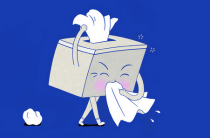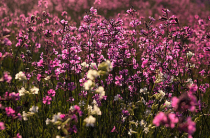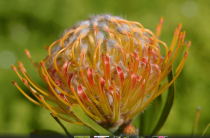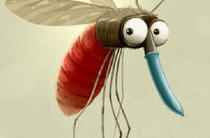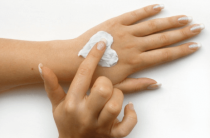Flower allergy is a seasonal bout of an allergic reaction that manifests itself upon contact with the pollen of a plant - an allergen. The real reason why exposure to plant pollen causes such a violent reaction in certain types of people is unknown. After all, most people more than calmly endure the ingress of pollen into the body. Even if it's ragweed pollen.
An allergy is an increased sensitivity of the body to some environmental factors that do not pose any danger to the body at all. Plant pollen is an absolutely harmless substance, in contrast to the pathogenic intestinal flora, with intensive reproduction and vital activity of which the same manifestations are observed as with allergies. But in this case we are talking about dysbacteriosis, since it is caused by alien and harmful bacteria, and not harmless substances.
Allergy to flowering has a clear seasonal focus and it occurs, from the beginning of the appearance of the pollen of an allergenic plant in the air and with the end of flowering, it gradually fades away. How quickly the allergy symptoms disappear, at the end of flowering, depends entirely on the individual characteristics of the patient's body. Flowering plants occur from early April until October. Allergy to pollen, in general, almost never occurs. Basically, the patient shows signs of allergy when one plant blooms. It can be either herbs or flowers, or trees.
According to general statistics, several peaks stand out during the pollination of the most common allergens: from March to June, trees (birch, hornbeam, beech, ash, linden, etc.) bloom; July - August is marked by the flowering of cereal crops and from August to mid-autumn, weeds bloom.
Plant pollen is dangerous because it is very easily carried by the wind. The only way to completely avoid the pollen of a plant - an allergen - is to move to an area where it does not grow during its flowering period. It is not even necessary to be near the place of growth, the wind carries pollen for many kilometers. It easily penetrates the home and you can protect yourself from it only through special events, which we will definitely inform you about a little later.
Flower allergy symptoms
With an allergy to flowering, the development of symptoms is clearly outlined by the flowering of the plant, to the pollen of which the patient is allergic. An allergy to flowering is primarily manifested by the sensitivity of the organs of vision and the respiratory system - these are the main organs that come into contact with pollen. When allergic to flowering, symptoms of allergic rhinitis, allergic conjunctivitis and bronchial asthma are noted.
allergic rhinitis
Allergic rhinitis is the appearance of inflammatory processes that are exclusively allergic in nature and localized in the nasopharynx.
With an allergy to flowering, the symptoms of allergic rhinitis are manifested by nasal congestion, which is caused by the expansion of local blood vessels; swelling of the nasopharynx; constant sneezing; allergic rhinitis, with the release of a clear secretory fluid.
Allergic rhinitis develops as a result of an immediate immune response caused by the activity of histamine to local receptors located in the larynx, nasopharynx and adjacent areas. When plant pollen enters, the symptoms of allergic rhinitis appear after 10-20 minutes. Allergic rhinitis causes significant discomfort, up to the need to change the usual rhythm of life. The most unpleasant consequence of this disease is a violation of nasal breathing, which provokes migraine attacks, causes weakness and daytime sleepiness.
During allergic rhinitis, in order to relieve symptoms, nasal vasoconstrictors are used, which, due to the effect on the tone of local vessels, cause a temporary relief of nasal congestion. But their uncontrolled use threatens drug addiction. And patients with allergic rhinitis, note the development of nasal congestion all year round, if there is no use of vasoconstrictors.
Allergic conjunctivitis
Allergic conjunctivitis is an inflammatory process localized in the region of the eye membrane, initiated by exposure to allergens. With an allergy to flowering, allergic conjunctivitis, in most cases, goes away with allergic rhinitis. The mucous membrane of the eye is an extremely vulnerable and sensitive place, which, when allergic to flowering, is often exposed to contact with allergens. This leads to the fact that the patient begins to develop allergic conjunctivitis.
Allergic conjunctivitis with pollen allergy is manifested by swelling of the eyes, tearfulness, decreased vision, dilation of local vessels, increased sensitivity to light sources, and the sensation of a foreign object is constantly present in the eyes.
For the treatment of allergic conjunctivitis, the following agents are used: sodium cromoglycate solution (mast cell membrane stabilizer), often another drug of this group, alomid, acts as its analogue; corticosteroid eye drops: dexamethasone or cortisone.
Bronchial asthma
With an allergy to pollen, bronchial asthma of an immune nature occurs, that is, associated with the work of the immune system. Manifestations, in this case, are similar to ordinary bronchial asthma, when an allergen enters a patient with an asthmatic nature of the course of the disease, bronchospasm occurs, which is fraught with respiratory failure, asthma attacks, accompanied by a dry cough and a feeling of compression in the chest area. Asthma attacks are more dangerous for the elderly. In this case, the risk of death is extremely high.
Flower allergy treatment
For allergy sufferers, there is very important, comforting news: an allergy to flowering can be successfully dealt with. Provided that you have contacted a competent specialist and strictly follow the course of treatment prescribed to you.
To combat the unpleasant symptoms that accompany an allergy to flowering, various drugs are used, both local and systemic. Local remedies are various eye drops , as well as drops and sprays for the nose. Systemic agents are antihistamines, in the form of tablets, as well as injectable corticosteroids.
Antihistamines for flower allergies
Antihistamines are drugs whose active ingredients have the ability to replace histamine when in contact with H1 receptors. This group of receptors, when exposed to histamine, provoke allergy symptoms in the cells of the skin, mucous membranes, and bronchi. Antihistamines eliminate skin itching, manifestations of dermatitis and allergic urticaria, symptoms of allergic rhinitis and conjunctivitis, relieve swelling of the skin and mucous membranes.
Diphenhydramine is an early drug that has a pronounced effect on the suppression of histamine activity in relation to the development of allergy symptoms.
Effective in preventing the symptoms of an allergic reaction, as well as to eliminate them. A significant disadvantage of diphenhydramine is its strong inhibitory effect on the central nervous system. After taking diphenhydramine, weakness, lethargy, and a constant feeling of fatigue develop.
Diazolin is a drug that causes depression of the central nervous system to a much lesser extent than diphenhydramine. The active substance of this drug increases the acidity of the stomach, as a result of which disorders of the gastrointestinal tract may occur.
Suprastin is a drug for the rapid relief of allergic reactions. Quickly relieves allergy symptoms, is an effective drug for neutralizing the symptoms of allergic conjunctivitis and allergic rhinitis. It has a moderate inhibitory effect, which is manifested by a feeling of light daytime sleepiness, which, however, is easily tolerated.
Tavegil is a drug with a powerful, rapidly developing antihistamine effect. The action takes about 8 hours. The disadvantage of tavegil is a strong inhibitory effect on the central nervous system, similar in intensity to that of demidrol.
Peritol - the effectiveness of the drug is due to the fact that it has not only an antihistamine effect, but also inhibits the activity of serotonin, which also takes an auxiliary part in the development of allergy symptoms.
Fenistil is an effective drug against allergies, which has a minimal inhibitory effect on the nervous system.
Claritin is an effective antihistamine drug with a powerful effect and minimal side effects. Does not cause drowsiness and lethargy, does not affect concentration.
Eye drops for allergy to flowering
Not all eye drops are suitable for the long-term treatment of allergic reactions. Eye drops are used, without fail, in compliance with the terms established by the doctor, for their use.
Eye drops contain various solutions of active drugs adapted for local use in the eye area:
Corticosteroid-based drops are drugs intended for short-term use.
They have powerful anti-inflammatory and anti-allergic properties. action. Vasoconstrictor drops.
Drops that contain substances that have a vasoconstrictive effect. They are used no more than five days in a row, in order to prevent the development of drug dependence; Antihistamine drops, for topical use.
Nose drops for allergies to flowering
Antihistamine nasal drops and sprays are the main topical agents used to relieve the symptoms of allergic rhinitis. They contribute to the local suppression of histamine activity in the nasopharynx, thereby alleviating and eliminating allergy symptoms. The advantage of antihistamines in the form of drops is a higher rate of elimination of symptoms of allergic rhinitis.
Hormonal drops and sprays in the nose are used when other medicines are ineffective, as well as to relieve acute manifestations of allergies.
They are used for short term therapy. If these drops are used for a long time, then the likelihood of side effects increases extremely. Vasoconstrictor drops (naphthyzinum, nafazoline) are used only in case of acute symptoms, to relieve allergic vasodilation. They should not be used for more than 5 days in a row, because in this case, drug dependence develops.
Also, solutions for washing the nasal cavity can be attributed to this category of funds for the treatment of pollen allergy. It can be either self-made solutions or special products purchased at a pharmacy. Their use allows you to remove pollen particles that accumulate on the nasal villi and provoke the further development of allergic rhinitis, when it would seem that contact with the allergen has already ceased.
Preventive measures against pollen allergy
- Refrain from morning and afternoon walks, as well as low humidity and high windiness;
- Do wet cleaning as often as possible;
- Use air filters and air conditioners;
- Use sunglasses and respirators if you are going to walk in adverse conditions;
- Rinse your nose, after a walk, wash your face, as well as wash your hair and exposed areas of the body


